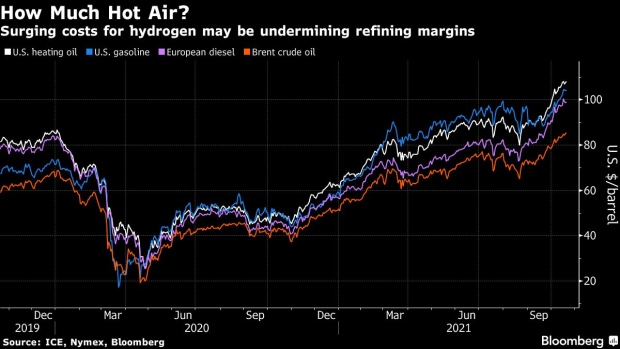Oct 21, 2021
Oil Refining Renaissance Under Threat From Natural Gas Crisis
, Bloomberg News

(Bloomberg) --
Surging prices for natural gas are threatening to eat up the profit some oil refiners are making on their fuels, forcing them to cut processing rates and even altering normal crude-buying patterns.
Natural gas -- specifically methane -- is central to making the hydrogen that oil refineries rely on for diesel-producing machines called hydrocrackers and hydrotreaters, which help to eliminate sulfur.
The natural gas price surge has added up to $6 per barrel to the cost of processing more sulfurous crudes -- as much as a tenfold increase compared with two years ago -- according to the International Energy Agency. As well as creating uncertainty about what a revival in refining margins, it yet another example of how the energy crisis is sprawling across markets and industries.
“If you’re a European refinery you’re making hydrogen by steam reforming of methane, and the price of methane is unbelievable,” said Callum Macpherson, head of commodities at Investec Plc. “If you’re in Europe or Asia it’s very, very expensive so it’s bound to have an impact.”
The hike might, in theory, make some refinery operations unprofitable, the IEA, an adviser to oil-consuming nations said. Making hydrogen is a very energy-intensive process.
Long-Term Contracts
The extent of the problem is far from clear because an unknown proportion of refineries will have secured their gas through long-term contracts, meaning they aren’t exposed to spot prices, according to the IEA. That means it’s not easy to know exactly how overall margins -- or the decisions that refineries take on crude selection -- will be affected.
Physical oil traders say the natural gas surge is affecting which grades refineries prefer, and that some hydrocrackers in Europe may have to cut how much they process. Refiners have also switched to using liquefied petroleum gas instead of natural gas in units where hydrogen is produced. That “reduces efficiency but can cut costs at these extreme price levels,” said Robert Campbell, an analyst at consultant Energy Aspects Ltd.
An official at one oil refinery in the Mediterranean said higher natural gas prices may reduce oil-processing margins by $3 to $5 a barrel, hurting profits just as the market for fuels is showing clear signs of recovery. Traders in Europe said that the demand for lower-sulfur crudes has outpaced interest in high-sulfur varieties.
North Sea barrels, which are generally sweeter, meaning they have less sulfur, have been strengthening over the past two weeks, amid strong buying from TotalEnergies SE and Litasco SA. Forties, a grade that is central to setting the region’s benchmark oil price, was recently bid at a premium of about 50 cents a barrel in pricing window run by S&P Platts, up by 40-50 cents from 10 days ago.
U.S. Shielded
By contrast, some sour grades continue to struggle to clear. Russia’s Urals crude, a relatively high-sulfur grade that is often handled in more sophisticated refineries, has been selling relatively slowly recently. It last traded at a discount of $2.40 a barrel to Dated Brent on Monday, much weaker than this time last year. Crudes from the U.S. and West Africa have also become more attractive in Europe, according to Energy Aspects.
For refiners in the U.S., the picture is slightly different. Natural gas prices there have risen more modestly, shielding the plants from the kind of soaring prices affecting in Europe and Asia. That means they can continue to process sulfurous barrels, which are starting to trade at increasing discounts.
Mars Blend, a high-sulfur crude, has been trading at an average discount of $3.29 a barrel to the low-sulfur grade Light Louisiana Sweet this month, the widest differential between the two grades in the past year. U.S. traders said the situation should free up increased exports of lighter, sweeter crudes for export toward Europe and Asia.
One trader said a rare cargo of heavy sweet Canadian crude, which usually finds a home in the U.S. Gulf, is instead sailing to Europe.
“All refiners are finely honing their models trying to work out the best mode of operation that reduces input costs, taking into account the value of the products being produced,” said Jonathan Leitch, an analyst at Turner, Mason and Co.
©2021 Bloomberg L.P.


